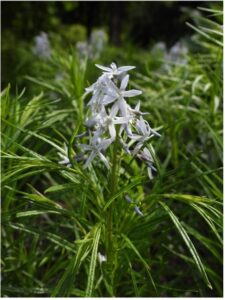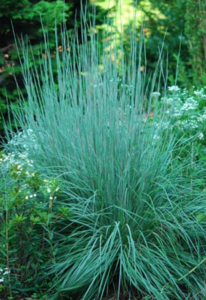Kolby Jergens, a landscape designer at Jensen Gardens, shares his favorite plants for the season.
Ninebark
Physocarpus opulifolius
Large Size 6-8’ tall and wide
Small Size 3-4’ tall and wide
Ninebark is a plant that is used frequently currently and for good reason. From being used as a hedge, for erosion control, or specimen planting Ninebark has many uses within a garden. Leaf colors can range from dark purple to orange copper to chartreuse yellow. The color combinations provide a lot of options when creating a planting plan. Ninebark tolerates clay and rocky soils and is known to grow in harsh conditions. Full sun is the best location for Ninebark. Pink or white blooms appear from May to June. There are numerous cultivars that have been developed and some of our favorites are ‘Little Devil’, ‘Coppertina’, and ‘Tiny Wine’. Fall color ranges depending on the cultivar but exfoliating bark on stems provides some winter interest. Ninebark flowers on old growth so it is best to prune just after flowering. Pruning should be done minimally by cutting back by about 1/3 of the overall size of the shrub. Removing dead stems can help promote new growth. When using the larger cultivars renewal pruning may be required after the shrub has reached full size. Renewal pruning is the process of cutting the shrub back by several feet.
control, or specimen planting Ninebark has many uses within a garden. Leaf colors can range from dark purple to orange copper to chartreuse yellow. The color combinations provide a lot of options when creating a planting plan. Ninebark tolerates clay and rocky soils and is known to grow in harsh conditions. Full sun is the best location for Ninebark. Pink or white blooms appear from May to June. There are numerous cultivars that have been developed and some of our favorites are ‘Little Devil’, ‘Coppertina’, and ‘Tiny Wine’. Fall color ranges depending on the cultivar but exfoliating bark on stems provides some winter interest. Ninebark flowers on old growth so it is best to prune just after flowering. Pruning should be done minimally by cutting back by about 1/3 of the overall size of the shrub. Removing dead stems can help promote new growth. When using the larger cultivars renewal pruning may be required after the shrub has reached full size. Renewal pruning is the process of cutting the shrub back by several feet.
Blue Star Amsonia, Arkansas Blue Star
Amsonia hubrichtti
Size: 2-4’ Tall and Wide
2011 Perennial Plant of Year by the Perennial Plant Association
I first came across this plant when traveling to Chicago to visit my sister. The Lurie Garden in Millennium Park was something I had heard about and knew that I had to make a stop. It was in the middle of fall and upon walking into the garden I instantly noticed the wide patches of golden yellow. I wanted to know more about this plant as that experience still resonates with me 8 years later. Amsonia hubrichtti tolerates moist/sandy soil to heavy clay soils. Rabbits and Deer will leave this plant alone because it produces a waxy substance when chewed upon. Full sun is the best location for Amsonia. It will tolerate some shade but can tend to flop over if there is too much shade. Pale blue flowers appear from April to May on top of fine texture leaves resembling a fern. When the plant really shines is in the fall as the entire plant will change to golden yellow color that is very striking. Blue Star Amsonia grows quickly and looks best when planted in mass amongst prairie grasses or other Perennials with coarser textures. Amsonia should be cut to about 3” above the ground in the spring when new growth begins to appear.
something I had heard about and knew that I had to make a stop. It was in the middle of fall and upon walking into the garden I instantly noticed the wide patches of golden yellow. I wanted to know more about this plant as that experience still resonates with me 8 years later. Amsonia hubrichtti tolerates moist/sandy soil to heavy clay soils. Rabbits and Deer will leave this plant alone because it produces a waxy substance when chewed upon. Full sun is the best location for Amsonia. It will tolerate some shade but can tend to flop over if there is too much shade. Pale blue flowers appear from April to May on top of fine texture leaves resembling a fern. When the plant really shines is in the fall as the entire plant will change to golden yellow color that is very striking. Blue Star Amsonia grows quickly and looks best when planted in mass amongst prairie grasses or other Perennials with coarser textures. Amsonia should be cut to about 3” above the ground in the spring when new growth begins to appear.
Little Bluestem
Schizachyrium scoparium
Size 2-4’ Tall 1-3’ Wide
2022 Perennial Plant of Year by the Perennial Plant Association
Prairie grasses and Nebraska go together like peanut butter and jelly. They are some of the best plants for our soils and climate as they are incredibly tough and adaptable. Little Bluestem can be found all over fields and prairies across the state. Native plants often get a reputation for being like weeds or having an unruly appearance. In the case of Little Bluestem, the adaptability and Fall color are something that truly makes this plant unique and worth planting. Little Bluestem will tolerate clay soil, high heat, drought, deer, poor soil conditions, and much more. Typically, around the end of May or early June new growth will start to appear from the root system. Summer growth will appear blue green in color and reddish-purple seed heads will start to appear in August. Fall color can range from copper or crimson and will remain through winter. The fall color provides great interest in the winter when most plants have gone dormant. There are multiple cultivars of Little Bluestem that have been introduced into the landscaping industry that provide better fall color, more sturdy steams, or more compact sizes. Our Favorites are ‘Standing Ovation’ ‘Blue Heaven’ or ‘Smoke Signal’. Bluestem should be cut to about 3” above the ground in late spring when new growth starts to appear. Cutting down in late fall is also acceptable but you will lose the winter interest.
and climate as they are incredibly tough and adaptable. Little Bluestem can be found all over fields and prairies across the state. Native plants often get a reputation for being like weeds or having an unruly appearance. In the case of Little Bluestem, the adaptability and Fall color are something that truly makes this plant unique and worth planting. Little Bluestem will tolerate clay soil, high heat, drought, deer, poor soil conditions, and much more. Typically, around the end of May or early June new growth will start to appear from the root system. Summer growth will appear blue green in color and reddish-purple seed heads will start to appear in August. Fall color can range from copper or crimson and will remain through winter. The fall color provides great interest in the winter when most plants have gone dormant. There are multiple cultivars of Little Bluestem that have been introduced into the landscaping industry that provide better fall color, more sturdy steams, or more compact sizes. Our Favorites are ‘Standing Ovation’ ‘Blue Heaven’ or ‘Smoke Signal’. Bluestem should be cut to about 3” above the ground in late spring when new growth starts to appear. Cutting down in late fall is also acceptable but you will lose the winter interest.
For all of your landscaping needs, contact Jensen Gardens.

